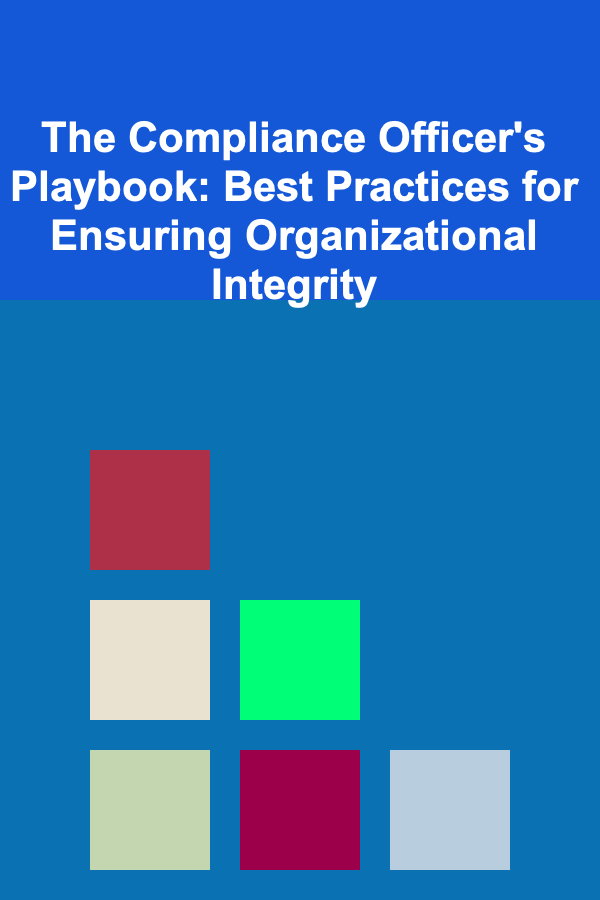
The Compliance Officer's Playbook: Best Practices for Ensuring Organizational Integrity
ebook include PDF & Audio bundle (Micro Guide)
$12.99$10.99
Limited Time Offer! Order within the next:

In today's complex and fast-paced business environment, the role of a compliance officer has become more important than ever. As organizations navigate the intricacies of laws, regulations, and ethical considerations, a compliance officer serves as the guiding force that ensures the company operates with integrity and in full adherence to applicable rules. This actionable guide explores the best practices compliance officers can employ to foster a culture of organizational integrity and mitigate risks while achieving long-term success.
Understanding the Role of a Compliance Officer
A compliance officer is more than just a rule enforcer or risk manager. Their role is to ensure that the organization complies with legal and regulatory requirements, internal policies, and ethical standards. However, the compliance officer's influence extends far beyond ensuring that rules are followed; it encompasses the broader responsibility of instilling an ethical culture that permeates every layer of the organization.
Key Functions of a Compliance Officer:
- Regulatory Adherence: Ensuring the organization complies with both industry regulations and local/national laws.
- Risk Management: Identifying and addressing potential risks before they manifest as larger issues.
- Policy Development and Enforcement: Establishing policies that define ethical behavior and operational best practices.
- Training and Awareness: Educating staff about compliance obligations and the importance of ethical behavior.
- Reporting and Investigations: Overseeing mechanisms for reporting violations and managing investigations.
To be effective in this role, compliance officers must combine a strong understanding of legal frameworks with a deep commitment to organizational values and ethics. Below, we outline actionable strategies for compliance officers to adopt in order to promote organizational integrity.
Build a Strong Compliance Framework
A solid compliance framework forms the backbone of any effective compliance program. It sets clear standards and expectations, which provide a foundation for monitoring and enforcement.
Develop Clear Policies and Procedures
The first step in establishing a compliance framework is creating comprehensive policies and procedures. These should cover both general compliance issues, such as adherence to laws, as well as specific challenges unique to the organization. Clear, easily accessible documentation ensures that employees at all levels understand their responsibilities and the consequences of non-compliance.
Actionable Steps:
- Policy Review and Customization: Ensure that policies are updated regularly to reflect changes in laws or industry practices. Tailor policies to the specific needs of your organization and address potential risks.
- Employee Accessibility: Make sure that policies are easily accessible to all employees. This could involve creating an internal intranet or providing printed handbooks.
- Clear Definitions of Ethical Standards: Define what ethical behavior looks like within your organization, such as how employees should handle conflicts of interest, reporting misconduct, or dealing with confidential information.
Establish a Compliance Team
Compliance efforts cannot fall solely on the compliance officer's shoulders. A cross-functional team should be formed, with representatives from various departments (e.g., legal, HR, finance, IT) to provide diverse perspectives and expertise. The compliance team plays a key role in ensuring that compliance is integrated throughout the organization.
Actionable Steps:
- Assign Roles and Responsibilities: Each team member should have clear compliance responsibilities, based on their area of expertise.
- Create a Compliance Committee: Regular meetings with senior management and department heads will help ensure that compliance remains a priority across the organization.
Conduct Ongoing Risk Assessments
The landscape of business risks is ever-changing, from evolving regulations to emerging technologies. Compliance officers need to stay ahead of potential risks by conducting regular risk assessments.
Assess Internal and External Risks
A thorough risk assessment should evaluate both internal and external risks. Internal risks might involve employee behavior, data management, or operational processes, while external risks include changes in laws, cyber threats, or market conditions.
Actionable Steps:
- Create a Risk Assessment Framework: Develop a framework that helps identify, assess, and mitigate risks. Include financial, operational, reputational, and legal risks.
- Involve Key Stakeholders: Collaborate with other departments, such as legal and IT, to identify risks that may be outside the purview of compliance but still have a significant impact.
- Regularly Update Risk Profiles: Risk factors evolve, so it is important to reassess risks on a semi-annual or annual basis to ensure compliance is adapting to changing circumstances.
Implement Proactive Mitigation Strategies
Once risks are identified, compliance officers must work with leadership to mitigate these risks before they materialize. Proactive risk mitigation involves crafting strategies that limit exposure to potential violations or failures.
Actionable Steps:
- Automate Compliance Tasks: Leverage technology to automate monitoring systems and reduce human error. Automated tools can track compliance statuses, send reminders about legal changes, and identify areas of risk in real time.
- Build Strong Relationships with Regulators: Foster positive relationships with regulators to stay informed about changes in regulations and gain insights into the regulatory landscape.
Promote a Compliance-First Culture
An effective compliance program requires more than just policies and risk assessments---it requires a commitment to embedding compliance into the organization's core culture. Employees must be encouraged to not only comply with the law but also to embrace ethical behavior and speak up when they identify misconduct.
Lead by Example
Top management must lead by example and demonstrate their commitment to compliance. If leadership does not set the tone, it is unlikely that employees at lower levels will take compliance seriously.
Actionable Steps:
- Publicly Commit to Ethical Standards: Company executives should regularly communicate the importance of ethics and compliance in business operations.
- Foster Transparency and Accountability: Create a culture where ethical behavior is recognized and where employees can hold each other accountable for compliance violations.
Provide Regular and Engaging Training
Training is a critical component of ensuring that employees understand their compliance obligations and the consequences of non-compliance. However, training should not be a one-time event. To keep employees engaged, training must be ongoing and relevant to their specific roles.
Actionable Steps:
- Interactive Training Programs: Use online courses, simulations, and scenario-based learning to keep training sessions interactive and relevant.
- Tailor Training to Job Roles: Not all employees face the same compliance risks. Tailor training to specific roles and departments, such as IT security training for technical teams or anti-bribery training for sales and marketing.
- Continuous Education: Provide periodic refresher courses to ensure that employees stay current on compliance matters and any regulatory changes.
Foster an Open Reporting Environment
Creating an environment where employees feel safe reporting unethical behavior without fear of retaliation is crucial for maintaining a culture of integrity.
Actionable Steps:
- Implement a Whistleblower Program: Set up an anonymous whistleblower hotline or online portal where employees can report misconduct or compliance violations confidentially.
- Encourage Feedback: Regularly ask employees for feedback about the effectiveness of compliance efforts and their comfort level in reporting concerns.
Monitor and Audit Compliance Effectiveness
Compliance is not static. Even the most well-intentioned policies and practices can become outdated, and the effectiveness of the compliance program should be continuously evaluated to ensure it's functioning as intended.
Regular Compliance Audits
Audits are a powerful tool for ensuring that compliance programs are effective and for identifying potential areas of weakness. These audits can be performed internally or by third-party auditors to provide an objective perspective.
Actionable Steps:
- Schedule Periodic Audits: Set regular intervals for audits (e.g., quarterly or annually) to check compliance with both internal policies and external regulations.
- Utilize Internal and External Auditors: While internal audits are valuable, consider using external auditors for an unbiased review of your compliance program's effectiveness.
- Follow Up on Audit Findings: Ensure that audit findings are promptly addressed, and corrective actions are implemented in a timely manner.
Use Technology to Monitor Compliance
With the increasing complexity of business operations, technology can play a critical role in monitoring and enforcing compliance. Automated systems can help track compliance status across various departments and provide real-time alerts when issues arise.
Actionable Steps:
- Implement Compliance Software: Use specialized compliance management software to track regulatory requirements, employee training, and audit trails.
- Data Analytics and Reporting: Leverage analytics to identify patterns or potential areas of concern in compliance-related data.
Handle Violations with Care and Transparency
Even with the best compliance program in place, violations can still occur. When they do, it is important to handle them swiftly, fairly, and transparently.
Investigate Alleged Violations Thoroughly
Upon learning of a potential violation, the compliance officer should launch a comprehensive investigation to determine the facts of the case. Investigations should be impartial and respect the privacy and confidentiality of all parties involved.
Actionable Steps:
- Set Clear Investigation Protocols: Establish a clear process for investigating alleged violations, including how to gather evidence, interview witnesses, and document findings.
- Ensure Fair Treatment: Every employee involved in an investigation should be treated fairly and with due process.
Enforce Corrective Actions and Disciplinary Measures
When violations are confirmed, corrective actions should be taken promptly. These actions might include disciplinary measures, policy revisions, or additional training to prevent future occurrences.
Actionable Steps:
- Take Consistent Action: Ensure that violations are met with consistent, proportional disciplinary actions. This helps reinforce the importance of compliance across the organization.
- Communicate Actions Transparently: Be transparent about how violations are handled. Communicating the outcome of investigations and corrective actions helps build trust and demonstrates a commitment to integrity.
Stay Ahead of Evolving Regulations
The regulatory landscape is constantly changing, and compliance officers must stay informed about emerging laws, industry standards, and best practices to ensure ongoing compliance.
Continuously Monitor Regulatory Changes
Compliance officers must be proactive in keeping track of changes to laws and regulations that affect their organization's operations.
Actionable Steps:
- Monitor Regulatory Websites: Subscribe to newsletters or updates from regulatory bodies to stay informed about legislative changes.
- Engage with Legal Advisors: Work closely with legal teams or external legal advisors to interpret new regulations and ensure that they are implemented correctly within the organization.
Foster a Culture of Adaptability
As the regulatory environment evolves, compliance programs must be flexible and capable of adapting quickly to changes.
Actionable Steps:
- Regularly Review Compliance Practices: Periodically assess your compliance program to ensure it is up-to-date with the latest regulatory developments.
- Promote Continuous Improvement: Encourage a mindset of continuous improvement within the compliance team, adapting to new regulations or challenges as they arise.
Conclusion
Ensuring organizational integrity through a robust compliance program is not just about avoiding fines or penalties---it's about building a sustainable, ethical business that earns the trust of employees, customers, and regulators. By establishing strong policies, conducting regular risk assessments, fostering a culture of integrity, monitoring compliance continuously, and adapting to changes in the regulatory landscape, compliance officers can protect their organizations and help them thrive in an increasingly complex environment.
The path to compliance excellence requires proactive leadership, ongoing education, and a commitment to continuous improvement. By adopting these best practices, compliance officers can be the champions of organizational integrity, ensuring long-term success for their companies.

How to Incorporate Sustainability Practices into Camp Activities
Read More
How to Serve Food Buffet-Style for a Relaxed Home Party
Read More
How to Set Financial Goals for Your Home and Achieve Them
Read More
The Art of Learning: How to Stand Out by Acquiring New Knowledge and Skills
Read More
The Marketing Analyst's Guide: Leveraging Data to Drive Business Decisions
Read More
Top Tips for Buying Used Books and Textbooks: Save Money and Get Quality Reads
Read MoreOther Products

How to Incorporate Sustainability Practices into Camp Activities
Read More
How to Serve Food Buffet-Style for a Relaxed Home Party
Read More
How to Set Financial Goals for Your Home and Achieve Them
Read More
The Art of Learning: How to Stand Out by Acquiring New Knowledge and Skills
Read More
The Marketing Analyst's Guide: Leveraging Data to Drive Business Decisions
Read More